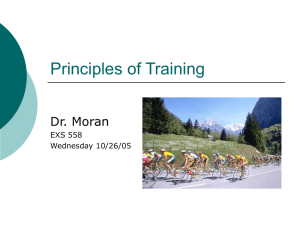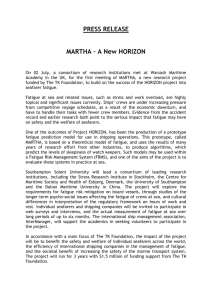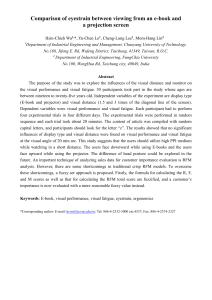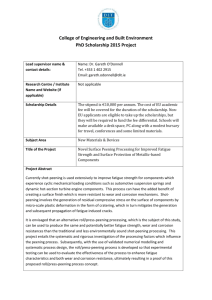NCCP Level 4 and 5, Task 6: Fatigue, Overtraining, Recovery
advertisement
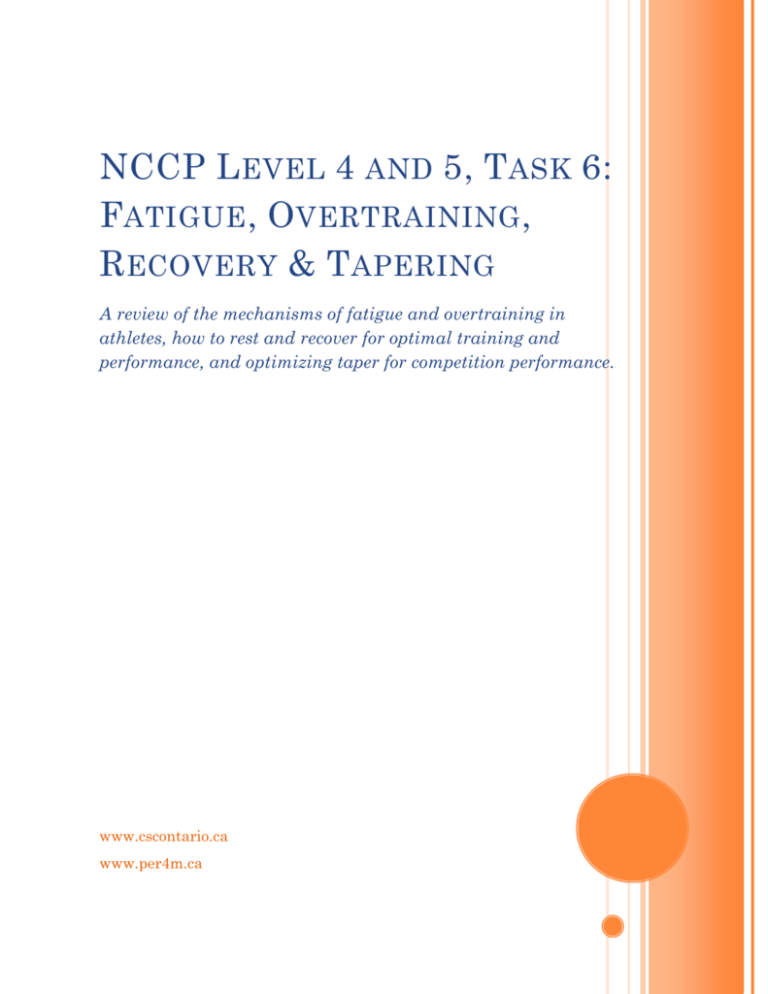
NCCP L EVEL 4 AND 5, T ASK 6: F ATIGUE , O VERTRAINING , R ECOVERY & T APERING A review of the mechanisms of fatigue and overtraining in athletes, how to rest and recover for optimal training and performance, and optimizing taper for competition performance. www.cscontario.ca www.per4m.ca Fatigue, Overtraining, Recovery & Tapering NCCP LEVEL 4 AND 5, TASK 6: FATIGUE, OVERTRAINING, RECOVERY & TAPERING A review of the mechanisms of fatigue and overtraining in athletes, how to rest and recover for optimal training and performance, and optimizing taper for competition performance. Task 6 is a comprehensive review of fatigue, overtraining, recovery and tapering that will help coaches develop a detailed understanding of the physiological mechanisms behind each. This workbook is designed to lead a coach through developing a resource of knowledge related to fatigue and avoiding overtraining in their sport, and developing a detailed recovery plan for their athletes. Fatigue The coach will be able to identify and explain the sport specific causes of fatigue in their athletes in training and competition. Overtraining The coach will be able to identify symptoms of overtraining in their athletes, and design and implement strategies to help athletes avoid and recover from overtraining. Recovery The coach will design, implement and evaluate specific strategies, programs and activities aimed at optimizing the athlete’s recovery and regeneration for specific training loads/stimuli. Taper The coach will design, implement and evaluate specific strategies, programs and activities aimed at optimizing the athlete’s recovery and regeneration for specific training loads/stimuli. Introduction to the workbook The purpose of this workbook is to validate your ability to implement some of the key concepts that have been presented and discussed during the course you have completed. In this document, you will be asked to reflect on the following: (1) The factors that are likely to be responsible for fatigue and performance decrements in your sport, both in the short and long terms. (2) The factors that are likely to cause overtraining in your sport. (3) Your responsibilities, and those of your athletes, in the process of designing, implementing and managing recovery strategies and optimal tapering for competition. You will also be asked to develop a series of action plans or activities in order to maximize the recovery of your athletes, both in training and in a competitive situation. Fatigue, Overtraining, Recovery & Tapering Learning Objectives: Fatigue 1. Be able to identify the primary causes of fatigue during sport training and competition; 2. Know some of the effects of Central Nervous System fatigue on the ability to train speed, strength and skills; 3. Identify how to recovery from fatigue during training and competition. Overtraining 1. Be familiar with the concept and specific symptoms of overtraining; 2. Know the general characteristics of fatigue and non-adaptive responses to training: overtraining (for the metabolic-physiological component of training); overuse (from a mechanical/structural point of view); and burnout (psychological and mental attitude towards training and competition); 3. Recognize nonadaptive responses to training; and overtraining symptoms; 4. Understand the following aspects of athletic injuries: psychological implications for the athlete, type of activities that can be performed to facilitate recovery and/or maintain fitness during the healing process, implications of returning to training/competition following incomplete recovery from an injury, factors the coach must consider when an athlete resumes training following an injury. Recovery 1. Understand that recovery is an integral component of a well-planned training program. 2. Understand that recovery involves all systems of the body and mind, e.e physical, nutritional, mental, emotional, etc… 3. Understand the amount of time needed for recovery to occur; 4. Be able to describe the nutritional strategies that can speed recovery from training; 5. Be familiar with simple tools that can help monitor the athlete’s recovery process; 6. Incorporate recovery modalities within his/her regular training programs and activities; 7. Be familiar with the regenerative effect of recovery modalities such as stretching, massage, hydrotherapy, rest and alternative activities. Taper 1. The coach will be ale to identify the physiological and psychological factors that are likely to adapt during tapering and how to optimize these; 2. The coach will be able to identify and minimize the negative adaptations that may occur during taper and prevent these, e.g., stress. 3. The coach will outline their tapering plan for a major competition. Fatigue, Overtraining, Recovery & Tapering SECTION 1: FATIGUE Coach Workbook – Fatigue Theme #1: Potential fatigue factors Identify the main factors that are or can become sources of fatigue for your athletes during training or competition. For each, identify a specific strategy in order to limit or reduce its impact, or to maximize recovery. Fatigue factor Recovery strategy to reduce or limit its impact Fatigue, Overtraining, Recovery & Tapering Theme #2: Symptoms of fatigue Based on your experience as an elite coach, how can you recognize that an athlete is showing signs of fatigue in your sport? Make a list of the main signs or symptoms which can be used as indicators of fatigue in your sport, both in training and during a competition. Consider the signs/symptoms that can be observed during a training session or a competition (short term signs), as well as those which may manifest themselves after several sessions or microcycles. a) Signs/symptoms that can be observed during a training session or a competition b) Signs/symptoms that can be observed after several training sessions or microcycles. Fatigue, Overtraining, Recovery & Tapering Theme #3: Monitoring fatigue status in your athletes Please outline the field tests or objective performance indicators you currently using or plan on implementing to monitor fatigue status in your athletes in order to assist you in identifying these signs or symptoms? Test/indicator 1: Description Rationale: Test/indicator 2: Description Rationale: Fatigue, Overtraining, Recovery & Tapering Test/indicator 3: Description Rationale: Test/indicator 4: Description Rationale: Fatigue, Overtraining, Recovery & Tapering Theme #4: Medical evaluation of your athletes Which laboratory or medical tests do you refer to in order to confirm your observations in the field? If you are not using any such tests currently, which could you consider using, and which criteria would provide you with information regarding the response of your athletes to training? Test/indicator 1: Description Rationale: Test/indicator 2: Description Rationale: SECTION 2: OVERTRAINING Coach Workbook – Prevention and management of overtraining Theme #1: Indicators/signs of overtraining Among the potential indicators or signs of overtraining that have been discussed during the course, identify those which are more likely to be useful in your sport (ex. Increased resting heart rate; poor quality of sleep; decreased willingness to train; etc.). For each, provide a brief explanation. Indicator 1: Description Physiological / psychological explanation: Indicator 2: Description Physiological / psychological explanation: Indicator 3: Description Physiological / psychological explanation: Fatigue, Overtraining, Recovery & Tapering Theme #2: Monitoring and interpretation Using these and / or additional indicators, monitor the recovery and adaptation to training of one of your athletes over a period of at least 45 days. Use the attached forms or, if you prefer, design your own monitoring tools and/or consider additional variables. Excel spreadsheets are preferable. During this monitoring process, you may want to draw some graphs to see the evolution of the variables you have selected, and visualize the trends. If you do so, please include a copy of these spreadsheets and graphs with your assignment. Possible factors to track include: Resting heart rate Rusko test results Quality of sleep Attitude toward training Muscle soreness on waking General level of fatigue Weight At the end of the 45-day period, and once you have compiled these data, provide a brief analysis of the information you have gathered and of the status of your athlete: Analysis: Fatigue, Overtraining, Recovery & Tapering Theme #3: Managing overtraining In the event that one of your athletes clearly showed signs of overtraining, what recovery strategies would you put in place, and what changes would you make to is/her training and competition program? Please provide a brief rationale. Changes to the training and competition program, and rationale: Recovery strategies and rationale: SECTION 3: RECOVERY AND REGENERATION Coach Workbook – Rest and Recovery Theme #1: Potential rest and recovery factors As an elite coach, you have some responsibilities in the area of planning the recovery and regeneration activities of your athletes. Indicate how the importance and/or the use of some recovery techniques or modalities could vary during the year, as your athletes progress from one phase of the training plan to another, and as the training load and the activities change. In this exercise, you may also want to consider the human and financial resources available to your programs, and how best to use them. Recovery technique or modality: How can the emphasis put on this particular technique or modality vary during the year, based on the activities included in your YTP? Recovery technique or modality: How can the emphasis put on this particular technique or modality vary during the year, based on the activities included in your YTP? Recovery technique or modality: How can the emphasis put on this particular technique or modality vary during the year, based on the activities included in your YTP? Fatigue, Overtraining, Recovery & Tapering Theme #2: Planning and managing recovery after training Making a list of the recovery strategies you could/would use after training session. Please provide a brief rationale. Recovery strategy after training session 1 Rationale Recovery strategy after training session 2 Rationale Recovery strategy after training session 3 Rationale Fatigue, Overtraining, Recovery & Tapering Theme #3: Planning and managing recovery after competition Making a list of the recovery strategies you could/would use after a competition. Please provide a brief rationale. Recovery strategy after minor in-season competition Rationale Recovery strategy after major competition Rationale Fatigue, Overtraining, Recovery & Tapering Theme #4: Responsibility In your opinion, and given the nature of your sport, what should the responsibilities of an elite coach be in the area of managing (e.g. following up and supervising) the recovery process of his or her athletes? It is important that athletes be capable of assessing how they are recovering, both from a physiological and a psychological point of view. Make a list of the signs and symptoms of fatigue which, in your opinion, are critical for an elite athlete to recognize in order to individually assess how he or she is responding to training. SECTION 4: OPTIMAL TAPERING FOR PEAK PERFORMANCE Coach Workbook – Designing the Optimal Taper Theme #1: Taper Design Outline your plan for a taper for a major competition. Note any planned changes in training frequency, intensity, and volume. Fatigue, Overtraining, Recovery & Tapering Theme #2: Potential stress factors Identify the main factors that are or can become sources of stress for your athletes during taper. For each, identify a specific strategy in order to limit or reduce its impact, or to optimize adaptation. Stress factor Strategy to reduce or limit its impact Fatigue, Overtraining, Recovery & Tapering Theme #3: Optimizing taper Identify the main factors that can enhance the adaptation of your athletes during taper. For each, identify a specific strategy in order to maximize its impact, and to optimize adaptation. Strategies can include sleep, nutrition, stress management, speed training in practice, stretching, massage, etc… Performance / adaptation enhancement technique 1: Rationale: Implementation plan: Performance / adaptation enhancement technique 2: Rationale: Implementation plan: Performance / adaptation enhancement technique 3: Rationale: Implementation plan: Performance / adaptation enhancement technique 4: Rationale: Implementation plan:



